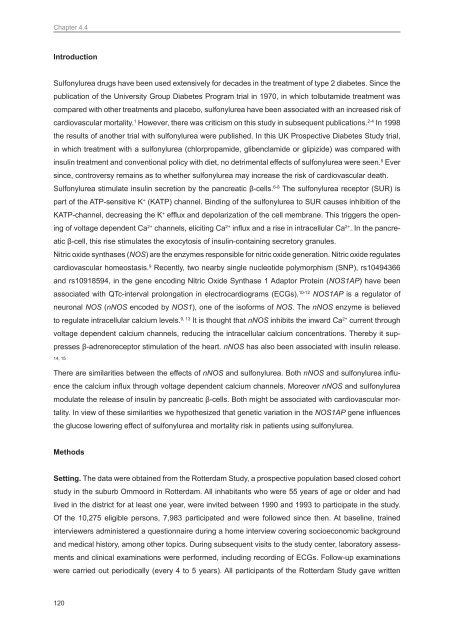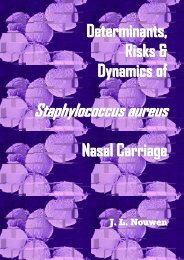Genetic susceptibility to adverse drug effects - Epidemiology ...
Genetic susceptibility to adverse drug effects - Epidemiology ...
Genetic susceptibility to adverse drug effects - Epidemiology ...
Create successful ePaper yourself
Turn your PDF publications into a flip-book with our unique Google optimized e-Paper software.
Chapter 4.4<br />
Introduction<br />
Sulfonylurea <strong>drug</strong>s have been used extensively for decades in the treatment of type 2 diabetes. Since the<br />
publication of the University Group Diabetes Program trial in 1970, in which <strong>to</strong>lbutamide treatment was<br />
compared with other treatments and placebo, sulfonylurea have been associated with an increased risk of<br />
cardiovascular mortality. 1 However, there was criticism on this study in subsequent publications. 2-4 In 1998<br />
the results of another trial with sulfonylurea were published. In this UK Prospective Diabetes Study trial,<br />
in which treatment with a sulfonylurea (chlorpropamide, glibenclamide or glipizide) was compared with<br />
insulin treatment and conventional policy with diet, no detrimental <strong>effects</strong> of sulfonylurea were seen. 5 Ever<br />
since, controversy remains as <strong>to</strong> whether sulfonylurea may increase the risk of cardiovascular death.<br />
Sulfonylurea stimulate insulin secretion by the pancreatic β-cells. 6-8 The sulfonylurea recep<strong>to</strong>r (SUR) is<br />
part of the ATP-sensitive K + (KATP) channel. Binding of the sulfonylurea <strong>to</strong> SUR causes inhibition of the<br />
KATP-channel, decreasing the K + efflux and depolarization of the cell membrane. This triggers the opening<br />
of voltage dependent Ca 2+ channels, eliciting Ca 2+ influx and a rise in intracellular Ca 2+ . In the pancreatic<br />
β-cell, this rise stimulates the exocy<strong>to</strong>sis of insulin-containing secre<strong>to</strong>ry granules.<br />
Nitric oxide synthases (NOS) are the enzymes responsible for nitric oxide generation. Nitric oxide regulates<br />
cardiovascular homeostasis. 9 Recently, two nearby single nucleotide polymorphism (SNP), rs10494366<br />
and rs10918594, in the gene encoding Nitric Oxide Synthase 1 Adap<strong>to</strong>r Protein (NOS1AP) have been<br />
associated with QTc-interval prolongation in electrocardiograms (ECGs). 10-12 NOS1AP is a regula<strong>to</strong>r of<br />
neuronal NOS (nNOS encoded by NOS1), one of the isoforms of NOS. The nNOS enzyme is believed<br />
<strong>to</strong> regulate intracellular calcium levels. 9, 13 It is thought that nNOS inhibits the inward Ca 2+ current through<br />
voltage dependent calcium channels, reducing the intracellular calcium concentrations. Thereby it suppresses<br />
β-adrenorecep<strong>to</strong>r stimulation of the heart. nNOS has also been associated with insulin release.<br />
14, 15<br />
There are similarities between the <strong>effects</strong> of nNOS and sulfonylurea. Both nNOS and sulfonylurea influence<br />
the calcium influx through voltage dependent calcium channels. Moreover nNOS and sulfonylurea<br />
modulate the release of insulin by pancreatic β-cells. Both might be associated with cardiovascular mortality.<br />
In view of these similarities we hypothesized that genetic variation in the NOS1AP gene influences<br />
the glucose lowering effect of sulfonylurea and mortality risk in patients using sulfonylurea.<br />
Methods<br />
Setting. The data were obtained from the Rotterdam Study, a prospective population based closed cohort<br />
study in the suburb Ommoord in Rotterdam. All inhabitants who were 55 years of age or older and had<br />
lived in the district for at least one year, were invited between 1990 and 1993 <strong>to</strong> participate in the study.<br />
Of the 10,275 eligible persons, 7,983 participated and were followed since then. At baseline, trained<br />
interviewers administered a questionnaire during a home interview covering socioeconomic background<br />
and medical his<strong>to</strong>ry, among other <strong>to</strong>pics. During subsequent visits <strong>to</strong> the study center, labora<strong>to</strong>ry assessments<br />
and clinical examinations were performed, including recording of ECGs. Follow-up examinations<br />
were carried out periodically (every 4 <strong>to</strong> 5 years). All participants of the Rotterdam Study gave written<br />
120









